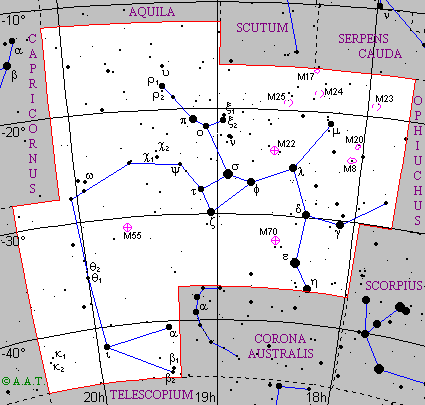 |
 |
| English name | Archer | ||||
|---|---|---|---|---|---|
| Major stars | gamma Sagittarii | Alnasl | magn. 3,1 | RA: 18h 05m 48.50s | Dec: -30° 25' 26.3" |
| delta Sagittarii | Kaus Media | magn. 2,8 | RA: 18h 20m 59.67s | Dec: -29° 49' 41.3" | |
| epsilon Sagittarii | Kaus Australis | magn. 1,9 | RA: 18h 24m 10.38s | Dec: -34° 23' 04.6" | |
| zeta Sagittarii | Ascella | magn. 2,7 | RA: 19h 02m 36.71s | Dec: -29° 52' 49.1" | |
| eta Sagittarii | magn. 3,2 | RA: 18h 17m 37.66s | Dec: -36° 45' 41.8" | ||
| lambda Sagittarii | Kaus Borealis | magn. 2,9 | RA: 18h 27m 58.26s | Dec: -25° 25' 17.7" | |
| pi Sagittarii | magn. 3,0 | RA: 19h 09m 45.84s | Dec: -21° 01' 24.9" | ||
| sigma Sagittarii | Nunki | magn. 2,0 | RA: 18h 55m 15.92s | Dec: -26° 17' 48.1" | |
| tau Sagittarii | magn. 3,4 | RA: 19h 06m 56.42s | Dec: -27° 40' 13.0" | ||
| phi Sagittarii | magn. 3,3 | RA: 18h 45m 39.37s | Dec: -26° 59' 26.8" | ||
| Description | Constellation of the zodiac, through which the Sun transits from the end of December to the end of January. It is to the northeast of Scorpius. Sagittarius contains many stars of average magnitude, but it is remarkable in particular for the great quantity of clusters and nebulas. The principal open clusters are in the northern zone of the constellation. M23 is an ample cluster composed by hundred stars, some of which reach the ninth magnitude: it is visible with good binoculars. M24 is really a zone of the Milky Way in which many stars are assembled in perspective. M25, finally, is a rather diffused cluster, composed by about 50 stars distributed around a yellow supergiant. To south the of M25 there is M22 a globular cluster of sixth magnitude: seen with small telescopes it appears of elliptical shape, while to resolve the single stars you need a telescope of average power.
|
||||
| Mythology and history | The constellation is identified with a centaur which bends a bow toward the near Scorpius: it is therefore the second centaur of the sky (the other one is just Centaurus). According to the version of Eratostenes, instead, the constellation represents Crotus, a satyr son of Pan: the satyrs were fantastic creatures with human bodies, two equine legs, tail and small horns. Crotus was the inventor of the bow (for this reason in the sky he bends a bow) and he loved to spend the time with the nine Muses, the divinities of arts: amused by his company, they asked Zeus to give him a place among the stars. |
||||
 Back to constellations page.
Back to constellations page.